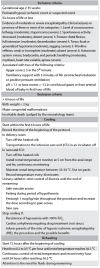Neuroprotective body hypothermia among newborns with hypoxic ischemic encephalopathy: three-year experience in a tertiary university hospital. A retrospective observational study
- PMID: 25351640
- PMCID: PMC10876352
- DOI: 10.1590/1516-3180.2013.7740026
Neuroprotective body hypothermia among newborns with hypoxic ischemic encephalopathy: three-year experience in a tertiary university hospital. A retrospective observational study
Abstract
Context and objective: Neonatal hypoxic-ischemic encephalopathy is associated with high morbidity and mortality. Studies have shown that therapeutic hypothermia decreases neurological sequelae and death. Our aim was therefore to report on a three-year experience of therapeutic hypothermia among asphyxiated newborns.
Design and setting: Retrospective study, conducted in a university hospital.
Methods: Thirty-five patients with perinatal asphyxia undergoing body cooling between May 2009 and November 2012 were evaluated.
Results: Thirty-nine infants fulfilled the hypothermia protocol criteria. Four newborns were removed from study due to refractory septic shock, non-maintenance of temperature and severe coagulopathy. The median Apgar scores at 1 and 5 minutes were 2 and 5. The main complication was infection, diagnosed in seven mothers (20%) and 14 newborns (40%). Convulsions occurred in 15 infants (43%). Thirty-one patients (88.6%) required mechanical ventilation and 14 of them (45%) were extubated within 24 hours. The duration of mechanical ventilation among the others was 7.7 days. The cooling protocol was started 1.8 hours after birth. All patients showed elevated levels of creatine phosphokinase, creatine phosphokinase- MB and lactate dehydrogenase. There was no severe arrhythmia; one newborn (2.9%) presented controlled coagulopathy. Four patients (11.4%) presented controlled hypotension. Twenty-nine patients (82.9%) underwent cerebral ultrasonography and 10 of them (34.5%) presented white matter hyper-echogenicity. Brain magnetic resonance imaging was performed on 33 infants (94.3%) and 11 of them (33.3%) presented hypoxic-ischemic changes. The hospital stay was 23 days. All newborns were discharged. Two patients (5.8%) needed gastrostomy.
Conclusion: Hypothermia as therapy for asphyxiated newborns was shown to be safe.
CONTEXTO E OBJETIVO:: A encefalopatia hipóxico-isquêmica neonatal apresenta alta morbi-mortalidade. Estudos com hipotermia comprovam diminuição de sequelas neurológicas e morte. Nosso objetivo foi então relatar experiência de três anos da hipotermia terapêutica em recém-nascidos (RN) asfixiados.
TIPO DE ESTUDO E LOCAL:: Estudo restrospectivo, conduzido em hospital universitário.
MÉTODOS:: Trinta e cinco pacientes com asfixia perinatal submetidos a resfriamento corporal entre maio de 2009 e novembro de 2012 foram avaliados.
RESULTADOS:: Trinta e nove RN preencheram os critérios do protocolo de hipotermia. Quatro RN foram excluídos devido a choque séptico refratário, não manutenção da temperatura e coagulopatia grave. A mediana do Apgar de 1o e 5o minutos foi de 2 e 5. A maior complicação foi infecção, diagnosticada em sete mães (20%) e 14 RN (40%). Convulsão ocorreu em 15 RN (43%). 31 pacientes (88,6%) necessitaram da ventilação mecânica e 14 (45%) foram extubados em 24 horas. O tempo de ventilação mecânica dos demais foi de 7,7 dias. O início do resfriamento ocorreu com 1,8 horas de vida. Todos os pacientes apresentaram níveis elevados de creatinofosfoquinase, creatinofosfoquinase-MB e desidrogenase lática. Não se observou arritmia grave; um RN (2,9%) apresentou coagulopatia controlada. Quatro pacientes (11,4%) tiveram hipotensão controlada. Realizou-se ultrassonografia cerebral em 29 pacientes (82,9%), 10 (34,5%) com hiperecogenicidade da substância branca. 33 RN (94,3%) fizeram ressonância magnética cerebral, 11 (33,3%) com alterações hipóxico-isquêmicas. O tempo de internação foi de 23 dias e todos receberam alta. Dois pacientes (5,8%) necessitaram de gastrostomia.
CONCLUSÃO:: A hipotermia como terapêutica para RN asfixiados demonstrou ser segura.
Conflict of interest statement
Figures
Similar articles
-
Hypothermia therapy for newborns with hypoxic ischemic encephalopathy.J Pediatr (Rio J). 2015 Nov-Dec;91(6 Suppl 1):S78-83. doi: 10.1016/j.jped.2015.07.004. Epub 2015 Sep 4. J Pediatr (Rio J). 2015. PMID: 26354871 Review.
-
Efficacy of passive hypothermia and adverse events during transport of asphyxiated newborns according to the severity of hypoxic-ischemic encephalopathy.J Pediatr (Rio J). 2018 May-Jun;94(3):251-257. doi: 10.1016/j.jped.2017.05.009. Epub 2017 Aug 18. J Pediatr (Rio J). 2018. PMID: 28822711
-
Therapeutic hypothermia for neonatal hypoxic-ischemic encephalopathy: magnetic resonance imaging findings and neurological outcomes in a Brazilian cohort.J Matern Fetal Neonatal Med. 2019 Aug;32(16):2727-2734. doi: 10.1080/14767058.2018.1448773. Epub 2018 Mar 13. J Matern Fetal Neonatal Med. 2019. PMID: 29504433
-
Predictive Value of Thompson-Score for Long-Term Neurological and Cognitive Outcome in Term Newborns with Perinatal Asphyxia and Hypoxic-Ischemic Encephalopathy Undergoing Controlled Hypothermia Treatment.Neonatology. 2018;114(4):341-347. doi: 10.1159/000490721. Epub 2018 Aug 21. Neonatology. 2018. PMID: 30130752
-
Risk factors for intraventricular hemorrhage in term asphyxiated newborns treated with hypothermia.Pediatr Neurol. 2014 Jun;50(6):630-5. doi: 10.1016/j.pediatrneurol.2014.01.054. Epub 2014 Feb 10. Pediatr Neurol. 2014. PMID: 24731482 Review.
Cited by
-
Use of high-sensitivity cardiac troponin I levels for early diagnosis of myocardial injury after neonatal asphyxia.J Int Med Res. 2019 Jul;47(7):3234-3242. doi: 10.1177/0300060519831187. Epub 2019 Jun 13. J Int Med Res. 2019. PMID: 31189368 Free PMC article.
-
Relevance of urinary S100B protein levels as a short-term prognostic biomarker in asphyxiated infants treated with hypothermia.Medicine (Baltimore). 2017 Nov;96(44):e8453. doi: 10.1097/MD.0000000000008453. Medicine (Baltimore). 2017. PMID: 29095291 Free PMC article.
-
Ultrasound stimulation of the vagal nerve improves acute septic encephalopathy in mice.Front Neurosci. 2023 Jul 17;17:1211608. doi: 10.3389/fnins.2023.1211608. eCollection 2023. Front Neurosci. 2023. PMID: 37529234 Free PMC article.
-
Cardiovascular Performance in Neonates with Hypoxic-Ischemic Encephalopathy Under Therapeutic Hypothermia: Evaluation by Conventional and Advanced Echocardiographic Techniques.Pediatr Cardiol. 2025 Jan 23. doi: 10.1007/s00246-025-03780-1. Online ahead of print. Pediatr Cardiol. 2025. PMID: 39847070
-
Incidence of encephalopathy and comorbidity in infants with perinatal asphyxia: a comparative prospective cohort study.Front Pediatr. 2024 Mar 27;12:1363576. doi: 10.3389/fped.2024.1363576. eCollection 2024. Front Pediatr. 2024. PMID: 38601274 Free PMC article.
References
-
- Procianoy RS, Silveira RC. Síndrome hopóxico-isquêmica [Hypoxic-ischemic syndrome] J Pediatr (Rio J) 2001;77(supl.1):S63–S70. - PubMed
-
- Kurinczuk JJ, White-Koning M, Badawi N. Epidemiolology of neonatal encephalopathy and hypoxic-ischaemic encephalopathy. Early Hum Dev. 2010;86(6):329–338. - PubMed
-
- Perlman M, Shah PS. Hypoxic-ischemic encephalopathy: challenges in outcome and prediction. J Pediatr. 2011;158(2 Suppl):e51–e54. - PubMed
-
- Gunn AJ. Cerebral hypothermia for prevention of brain injury following perinatal asphyxia. Curr Opin Pediatr. 2000;12(2):111–115. - PubMed
Publication types
MeSH terms
Substances
LinkOut - more resources
Full Text Sources
Other Literature Sources
Miscellaneous





